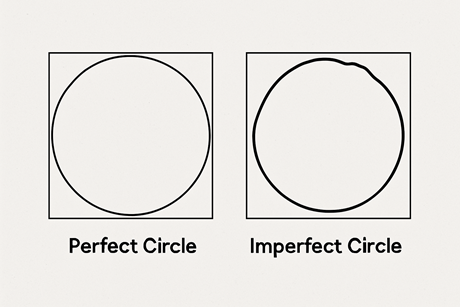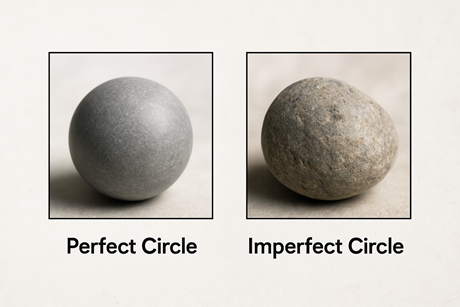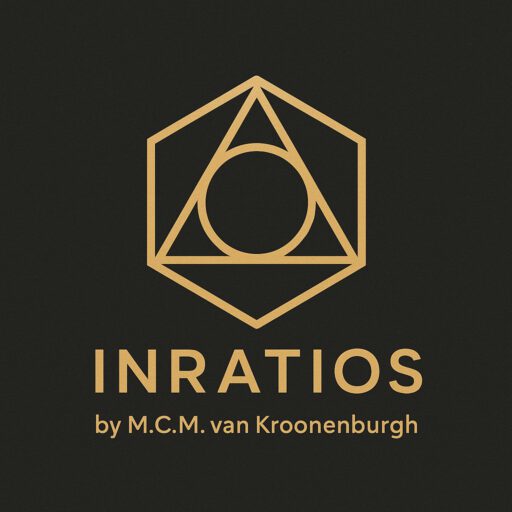Tolerance Is Not an Error
How GRM Handles Imperfection With Logic
When perfection breaks, meaning begins
In the physical world, nothing is perfect.
No edge is flawless, no circle truly complete.
Materials deform. Tools wobble. Time wears down precision.
Yet somehow, we still understand form.
We still recognize a circle, even when it’s a little off.
A square, even with rounded corners.
Because the human brain doesn’t need perfection.
It needs structure. And it needs margin.
So does the digital world.
But instead of intuition, it needs logic.
And that’s where classical geometry often falls short:
it defines only the ideal, not what lies near it.
This is where GRM begins to shine.
Because when you express a shape through proportion,
you don’t just define what it is.
You define what it almost is, too.
And that’s not noise.
It’s signal.
It’s tolerance, and it tells a deeper story.
The logic of near enough
In traditional geometry, a circle is either perfect, or it isn’t.
There’s no formal room for almost.
But in real-world design, in measurement, in life, “almost” matters.
GRM introduces a different logic.
Instead of judging form by visual resemblance or strict rules,
it asks a simpler question:
“How much of the container is filled?”
For a perfect circle inside a square, the answer is always 0.7854 SAU.
But what about a shape that fills 0.7750 SAU?
It’s not a perfect circle.
But it’s close.
Close enough to classify.
Close enough to recognize.
And, critically, close enough to tolerate.
This is the power of working with ratios:
- You’re not locked into formulas.
- You’re not relying on training data.
- You’re comparing structure to structure.

Figure 1 – “Deviation is not failure. It’s measurable.”
With GRM, every shape becomes part of a continuum of identity,
from perfect match to close resemblance to clear deviation.
This allows digital systems to:
- Accept variation without losing meaning
- Detect defects without guesswork
- Interpret structure, not just label it
Tolerance, in GRM, is not an afterthought.
It’s built into the ratio.
A shape that fills 0.7600 SAU might still be accepted as “circle-like”, depending on your threshold.

Figure 2 – Both are round. One is perfect. The other is real.
GRM bridges the gap, with ratio, not guesswork.
And that threshold?
It’s no longer arbitrary.
It’s programmable, measurable, and context-specific.
The beauty of not quite
Tolerance isn’t weakness.
It’s a recognition of reality.
Of how forms flex, how materials bend,
how perfection isn’t always the goal, but clarity is.
GRM gives us a way to make that clarity measurable.
To move beyond binary logic, “circle” or “not circle”,
into a spectrum of structural truth.
Because when you know the ideal ratio,
you also know how far you’ve drifted,
and how close is still close enough.
That’s not just a geometric trick.
It’s a philosophy of form.
And a powerful tool for design, diagnostics, AI, and beyond.
With GRM, difference becomes data.
Deviation becomes meaning.
And tolerance becomes the bridge between perfection and possibility.
In physical reality, we improvise.
But in digital systems, structure is king.
GRM thrives in that structure,
because it replaces uncertainty with proportion,
and ambiguity with measurable bounds.
It’s not just a fit for digital geometry,
it’s a foundation.
This closes our Rethinking Pi series,
but only the beginning of the bigger story.
Because once you start measuring with proportion,
you start seeing the world differently.
Ready to take that next step?
Then join us as we build the next logic layer:
Digital Geometry. Digital Physics. Digital Understanding.
Stay curious. Stay structured.
and thank you for following along.

